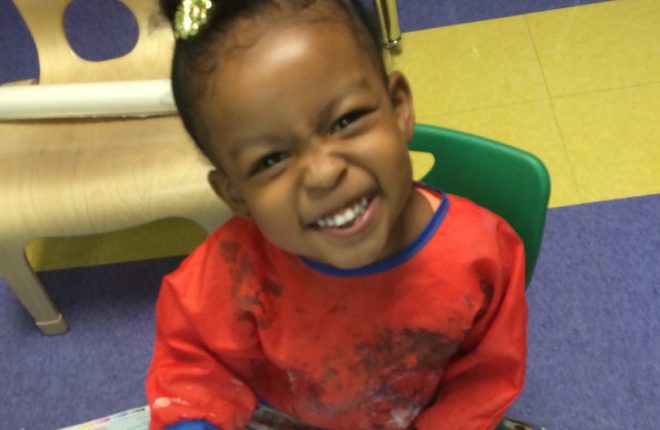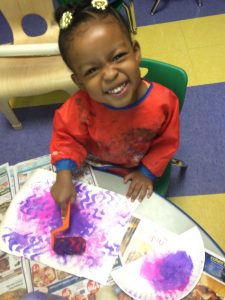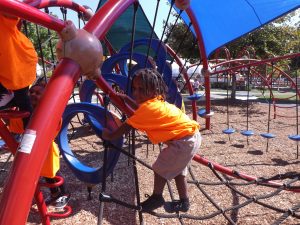Quality pre-K sets our children up for success. Nearly 85% of a child’s brain is formed by the time they turn five and those first few years are the most important to their brain development and long-term success. Children who attend quality pre-K programs are less likely to repeat a grade, more likely to graduate from high school, and less likely to need supportive services in school.
PHLpreK helps children and families prepare for Kindergarten and beyond by providing quality care and instruction to children. For this blog we partnered with PHLpreK program Something to Grow On to take you through a day in the life of a PHLpreK student.
Drop-Off and Breakfast
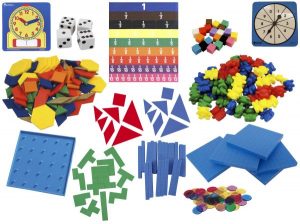
It’s 8:30am, and the pre-K students are arriving, greeted by their teacher and assistant teacher, they kiss their parents goodbye, so that they can join the activities of the day. Breakfast is served: Warm pancakes with syrup, apple sauce, and milk. Once hands and faces are washed, it is time for activities!
Math and Motor Skills
The classroom is arranged into centers, and the children go to the math and manipulative* areas to get puzzles, peg boards, pattern blocks, table blocks, matching cards and other manipulatives that assist in improving their fine motor skills.
Next, to get ready for circle time, the children clean-up their activities, push in their chairs, and find a cozy place to sit on the rug.
Circle Time and Music
Along with hand clapping, thigh tapping, and feet stomping, songs like Good morning to you and I am Special are sung. Next, it’s on to music and movement. Many children elect to play an instrument while others have decided to use their bodies to sway. Several children have gathered in a circle and begin to walk around and around.
Once the music is finished the children return to the rug to review the classroom rules. “What’s rule #1?” the teacher asks as she holds one finger in the air. The class shouts out “We help each other; we do not hurt each other.” After going over the remaining rules the children explore all the activity centers.
At the art center, children are mashing, tearing, rolling, and flattening clay. “Look!” a child says holding up her clay. The teacher kneels to the child’s chair and says, “Can you tell me about what you have created?” “I made a spider, look, there are eight legs, 1, 2, 3, 4, 5, 6, 7, 8” she counts. The teacher continues her questioning, “What if you were to make an insect, how many legs would it have?” The student exclaims, “Six!”
At the easel, a student is using the available colors to make a rainbow. The teacher sings the “rainbow song” with the child; the student notices that the color purple is missing. The teacher encourages the child to think about what two colors are needed to make purple. After much debate, it is decided that red and blue make purple.
At the computer, a student is creating patterns with beads, as the computer speaks, “orange, green, orange, green, what comes next?” The child pauses, and then replies, “orange!”
At the sand table a child has just added water to the sand. Seeing an opportunity for scientific exploration, the teacher asks, “What has happened now that we have added the water? How does the wet sand feel compared to the dry sand?”
Writing
At the writing table, a child is reviewing the letter of the week. The teacher asks, “What sound does the letter ‘Nn’ make? Can anyone give me a word that begins with the letter ‘Nn’?”
Science
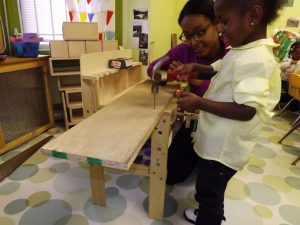
At the science center, there are magnifying glasses, a model of a nasal cavity, bug models, books and puzzles about space exploration, a skeleton called “Bob”, and plants. Paper and pencil are always available to allow the children to draw their observations.
Quiet Area
In the quiet/cozy area, soft stuffed toys and a puffy blanket provide an opportunity for a child to cozy up with a book, or perhaps have a quiet space to reflect.
Learning through Play
In the dramatic play area, food is the theme of the day as children dress as adults and feed their babies – preparing bottles, and baby food. Menus are available for take-out food, and teachers ask questions about how the students prepare some of their favorite dishes.
In the block area, there are 4 different types of blocks available to build with. The children are encouraged to think about ways that their foundations can be made more durable. Modes of transportation, animals, people, and train tracks are available for further imaginative play.
It is time for outdoor play. Children have a choice of scooters, riding toys, basketball, chalk, bubbles, a sand table, outdoor blocks, and hula hoops. Nature walks occur weekly when the weather is nice. This activity gives the teacher the opportunity to talk about the environment and gives the children an opportunity to describe what they see.
After lunch, the children spend more time at the centers, then it’s time for departures, and the teachers prepare for another day!

